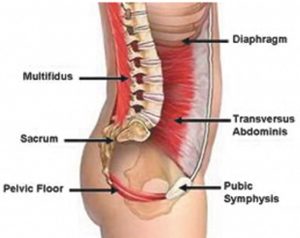By Shannon Willits


I’ve worked with many men that have spent their careers sitting. When they show up in the Pilates studio it is easy to see the postural distortions due to the adaptation of this repetitive posture. Postural distortions are a “use” issue, ie. overuse, underuse, misuse, abuse, etc. You get the idea. Sitting is an underuse/overuse dichotomy that is considered a life-threatening behavior. According to the NIH, Sedentary death syndrome (SeDS) is a major public health burden due to its causing multiple chronic diseases and millions of premature deaths each year.
Women present many similarities but often quite different, especially if they’ve had children. Whether vaginal or cesarean delivery, the pelvic floor function is not optimal and requires intervention to restore function.
Posture Matters
Posture is the position in which you hold your body upright against gravity while standing, sitting, lying down and walking. Your posture is the main reason pelvic floor damage happens. When you maintain good posture, the pressure is put on your bones, and your pelvic floor muscles can actually get stronger. When you’re seated for too long with poor posture, the pressure shifts and is put on your muscles. This is more prominent in individuals with poor posture, such as those with a rounded back or who slouch. Sitting for too long can compress your organs, adding additional pressure to the pelvic floor. Essentially, if you’re sitting for too long, your core and pelvic muscles can become strained, which eventually causes damage.
Pelvic Floor Recruitment and the Pilates Method
The pelvic floor is a set of muscles that supports the pelvic organs and hips for spinal stabilization support, applying intra-abdominal resistance and pelvic pressuring during coughing or lifting, housing the pelvic organs, and providing sensation in the pelvic floor (including genitals). These muscles are considered voluntary, meaning they can be contracted and also relaxed through conscious control.
Changes in recruitment of the pelvic floor muscles (PFM) can occur as a result of chronic stress, poor movement patterns, excessive sitting, trauma, surgery or childbirth. This altered recruitment often results in over activation of some muscles and under activation of others creating a series of imbalances. These imbalances usually do not spontaneously recover and can lead to other issues like chronic low back and pelvic pain, hip pain and even neck and shoulder pain.
A primary focus of the Pilates Method recognizes the pelvic floor as an integral part of “the core” and includes the PFM during training. Every Pilates exercise focuses on length and strength simultaneously making it a very efficient exercise method for men and women alike. Exercises like bridges, squats and biceps curls all focus on alignment, breathing and proper recruitment of the core, including the pelvic floor.
Beyond Kegals, The Pilates Method 3-Dimensional Diaphragmatic Breathing Techniques
Try this technique at home. Focus and maintain a 3-dimensional inhale breath throughout this exercise. In other words, expand the front, back and sides of your lower rib cage and lower belly on the inhale being mindful of neck and shoulder tension and then gently contract the abdominals on the exhale with a Shhh sound being mindful not to excessively force the exhale.
When contracting the PFM, a deep sense of drawing up from the pelvic floor (vaginal for women and perineum for men) and a gentle corseting of the abdominal wall. You should NOT feel your buttocks tighten, legs rotate out, movement of your spine or pelvis.
Now place your hands on the outside of your ribs. This time when contracting the PFM, a deep connection in the abdomen (under your hands) ideally is felt. Again, DO NOT squeeze the buttocks tighten, rotate the legs out, or move the spine or pelvis. If you feel a bearing down and out of the abdomen, butt gripping or spinal movement, you are not successfully connecting the PFM. Always remember, less is more.
Pilates is for Everybody
Pilates caters for everyone, from beginner to advanced. The health benefits of Pilates are almost endless, but some of the most popular include: improved flexibility, improved posture, improved dynamic strength and tone of the core, restoring muscular balance to the PFM, injury prevention, and less pain! You can perform exercises using your own body weight, or with the help of various pieces of apparatus.
A typical Pilates workout includes a number of exercises and stretches. Each exercise is performed with attention to diaphragmatic breathing techniques to dynamically recruit the PFM and abdominals. To gain the maximum benefit, Pilates should be done at least two or three times per week.
Pilates is great to do with your partner. Practicing Pilates together brings you more in tune with your own and each other’s body. You will understand range of motion better and can assist in light spotting techniques to get more out of practicing together than by yourself.
Shannon Willits, Master Pilates Educator
Shannon is a trained movement specialist holding prestigious certifications in STOTT Pilates, a fellowship in Applied Functional Science (FAFS) and is a Functional Golf Specialist. She has been studying various movement methods with an emphasis on healing for decades in order to keep her own body healthy. While Shannon has always been strong and flexible, her body was still fighting aches and pains. After her first Pilates class she felt a profound sense of well-being, and her aches and pains began to disappear. Trading her pantyhose and high heels for leggings and grip socks Shannon has had the privilege of bringing “Pilates for Everybody” to her community and creating an academy where she mentors aspiring Pilates instructors. Furthermore, Shannon is a master trainer for Club Pilates, Barre Above and Relief Through Rolling, which focuses on self-myofascial release. She is also certified in other movement modalities including TRX, the MELT Method, BOSU, Gyrotonic and more.
CLUB PILATES
Ft. Myers West
13211 McGregor Blvd, Unit 102-2
Fort Myers, FL 33919
(239) 603-7300
Ft. Myers Central
6891 Daniels Parkway, Ste #145
Fort Myers, FL 33912
(239) 603-7222
Estero
20321 Grande Oaks Shoppes Dr.
Estero, FL 33928
(239) 288-5521
Cape Coral West
2390 Surfside Blvd
Cape Coral, FL 33991
239-291-9090
 Southwest Florida's Health and Wellness Magazine Health and Wellness Articles
Southwest Florida's Health and Wellness Magazine Health and Wellness Articles

